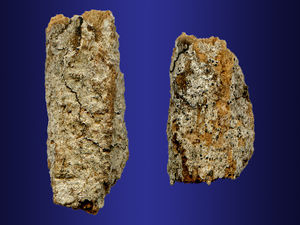Okoubaka aubrevillei
| Okoubaka aubrevillei | ||||||||||||
|---|---|---|---|---|---|---|---|---|---|---|---|---|

Pieces of bark from Okoubaka aubrevillei |
||||||||||||
| Systematics | ||||||||||||
|
||||||||||||
| Scientific name | ||||||||||||
| Okoubaka aubrevillei | ||||||||||||
| Pellegr. & Normand |
The tropical jungle tree Okoubaka aubrevillei , also called Okoubaka tree (English: Okoubaka tree ) and Okoubaka for short as a drug , is a West African tree and is particularly common in Nigeria , Ghana and the Ivory Coast . It belongs to the family of the sandalwood plants , but is also sometimes part of the related Olacaceae or earlier in a small family called Octoknemaceae.
Occurrence and description of plants
Up to 40 meters high, Okoubaka is a deciduous tree with a round crown and drooping branches . The trunk diameter reaches up to 3 meters. The trunk is fluted at the base. The rough bark is gray to reddish brown. The branches are hairy. It grows exclusively in closed forest stands. It's a hemiparasite .
The simple, short-stalked leaves are mostly alternate. The entire-edged and pointed, egg-shaped to lanceolate leaves, usually somewhat hairy on the underside, are up to 20 centimeters long and 3.5–6 centimeters wide. The base of the spade is slightly heart-shaped to rounded. The stipules are missing.
Okoubaka aubrevillei is monoecious . There are up to 20 centimeters long panicles formed. The green, sessile and very small, unisexual flowers are five-fold with a simple flower cover , the sepals are missing. It is a small, hairy flower cup . The outside short-haired, triangular petals, with inside a tuft of hair over the anthers, are up to 2.5–3 millimeters long, the female flowers are slightly larger. There are very small stamens and a pestle in the male flowers . In the pistillate flowers a vierkammeriger, upper permanent and smaller ovary with minimal stylus with vierlappiger scar formed and Staminodien. There is a lobed, hairy discus each.
The ellipsoidal, glabrous and solitary drupes are yellow, up to 9 (16) centimeters tall and hard. The large, ellipsoidal and ribbed-pitted stone core is up to 7 centimeters long.
Important ingredients and effects
The important ingredients of Okoubaka aubrevillei come from the bark . The stem bark can be described as Gerbstoffdroge and includes in addition to the tannins still catechins , gallic acid , protocatechuic and phenolic acids . A mother tincture of the bark has an astringent and woody taste. In investigations of the ingredients and pharmacology , a slight antibiotic and a strong phagocytosis- increasing effect were found.
Folk medicine
Natives in West Africa use the powdered bark of the okoubaka tree as medicine ( taken orally by teaspoon ) for the prevention of all kinds of poisoning and for severe forms of syphilis .
literature
- GH Schmelzer, A. Gurib-Fakim: Plant resources of tropical Africa 11 (1), Medicinal Plants 1, PROTA, 2008, ISBN 978-90-5782-204-9 , p. 392 ff.
- EM Veenendaal, IK Abebrese, MF Walsh, MD Swaine: Root Hemiparasitism in a West African Rainforest Tree Okoubaka aubrevillei (Santalaceae). In: New Phytologist. Vol. 134, No. 3, 1996, p. 487-493, JSTOR 2558566 .
Web links
- Okoubaka aubrevillei . In: S. Dressler, M. Schmidt, G. Zizka (Eds.): African plants - A Photo Guide. Senckenberg, Frankfurt / Main 2014.
- Photo of Okoubaka tree ( Memento from March 22, 2007 in the Internet Archive ).
- Okoubaka on similasan.ch.
